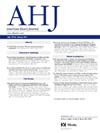Novel automated electronic medical record-based VEST (virtual echocardiography screening tool) algorithm for pulmonary arterial hypertension
IF 3.7
2区 医学
Q1 CARDIAC & CARDIOVASCULAR SYSTEMS
引用次数: 0
Abstract
Background
Pulmonary arterial hypertension (PAH) remains underrecognized and life-threatening due to limited awareness, nonspecific symptoms, and late referral to accredited pulmonary hypertension (PH) centers. The previously validated virtual echocardiography screening tool (VEST) predicts PAH hemodynamics. The objectives of the present study were to determine if the novel automated electronic medical record (EMR)-based algorithm could accurately calculate VEST scores to identify PAH hemodynamics and aid referral to PH specialty care.
Methods
This study is a retrospective analysis of 4,952 patients who underwent transthoracic echocardiogram (TTE) with tricuspid regurgitation velocity (TRV) ≥2.9 m/s in a hospital with an accredited PH Center of Comprehensive Care. Using the automated EMR-based algorithm, EMR-calculated VEST scores were calculated and compared to manually calculated VEST scores. Automated EMR VEST scores were used to identify those with highest risk for PAH (+3 score). Patients with +3 score were analyzed to determine whether they were evaluated within the accredited PH center or undergone right heart catheterization (RHC), the gold standard for PH diagnosis.
Results
Automated EMR VEST scores were validated with 100% correlation to 60 manual scores. Of 354 patients with +3 score, those that underwent RHC had severe PH, with mean pulmonary artery pressure 48 mm Hg and pulmonary vascular resistance 8.5 Wood units. One hundred and four patients (29.4%) were never referred for specialty PH care, and of these, only 37.5% underwent RHC. In the 250 patients referred to subspecialty PH care, 237 (94.8%) underwent RHC.
Conclusions
This novel EMR-based automated VEST calculator is a powerful yet simple scoring tool that can capture patients at high risk for PAH, prompting earlier diagnosis and referrals to accredited PH centers to allow for earlier expert care and implementation of medical therapies.
肺动脉高压的新型自动电子病历检测方法。
背景:肺动脉高压(PAH)仍未被充分认识并危及生命,由于认识有限,非特异性症状,以及未及时转诊到经认可的肺动脉高压(PH)中心。先前验证的虚拟超声心动图筛查工具(VEST)预测PAH血流动力学。本研究的目的是确定新的基于自动电子病历(EMR)的算法是否可以准确计算VEST评分,以识别PAH血流动力学并帮助转介到PH专科护理。方法:回顾性分析4952例三尖瓣反流速度(TRV)≥2.9 m/s的经胸超声心动图(TTE)患者。使用基于emr的自动算法,计算emr计算的VEST评分,并与人工计算的VEST评分进行比较。自动EMR VEST评分用于识别PAH风险最高的患者(+3分)。对+3分的患者进行分析,以确定他们是否在认可的PH中心进行评估或接受右心导管(RHC),这是PH诊断的金标准。结果:自动EMR VEST评分与60个手动评分的相关性为100%。354例+3分患者中,接受RHC的患者有严重的PH,平均肺动脉压48 mm Hg,肺血管阻力8.5 Wood单位。104名患者(29.4%)从未接受过专业的PH护理,其中只有37.5%接受了RHC。在250例接受亚专科PH治疗的患者中,237例(94.8%)接受了RHC。结论:这种新颖的基于emr的自动VEST计算器是一种强大而简单的评分工具,可以捕获PAH高风险患者,促进早期诊断和转介到经认证的PH中心,以便早期专家护理和实施医学治疗。
本文章由计算机程序翻译,如有差异,请以英文原文为准。
求助全文
约1分钟内获得全文
求助全文
来源期刊

American heart journal
医学-心血管系统
CiteScore
8.20
自引率
2.10%
发文量
214
审稿时长
38 days
期刊介绍:
The American Heart Journal will consider for publication suitable articles on topics pertaining to the broad discipline of cardiovascular disease. Our goal is to provide the reader primary investigation, scholarly review, and opinion concerning the practice of cardiovascular medicine. We especially encourage submission of 3 types of reports that are not frequently seen in cardiovascular journals: negative clinical studies, reports on study designs, and studies involving the organization of medical care. The Journal does not accept individual case reports or original articles involving bench laboratory or animal research.
 求助内容:
求助内容: 应助结果提醒方式:
应助结果提醒方式:


